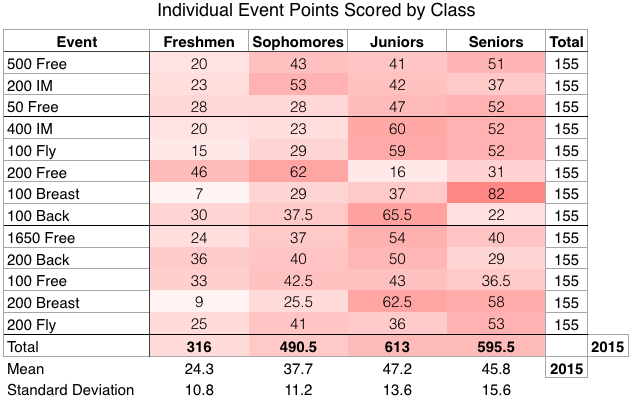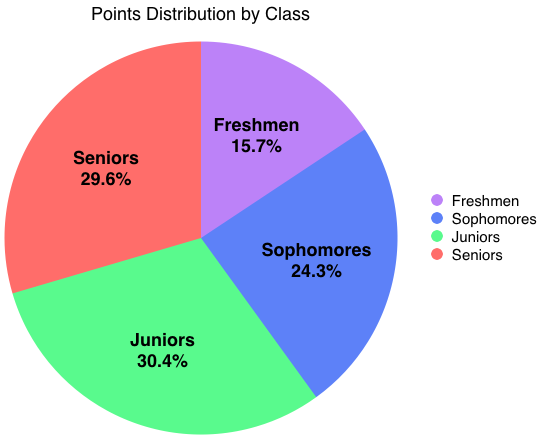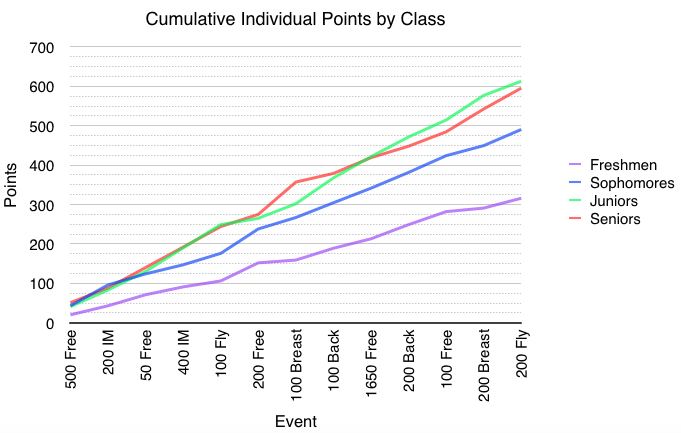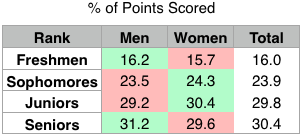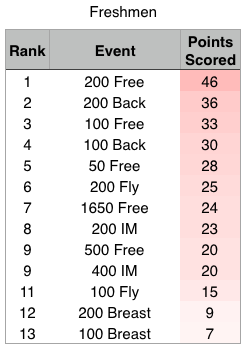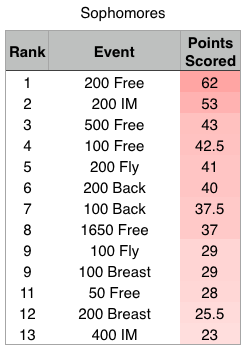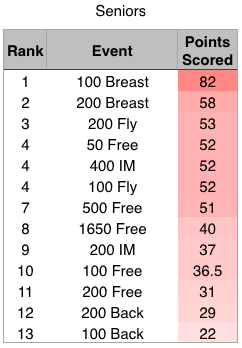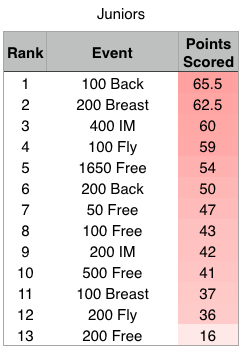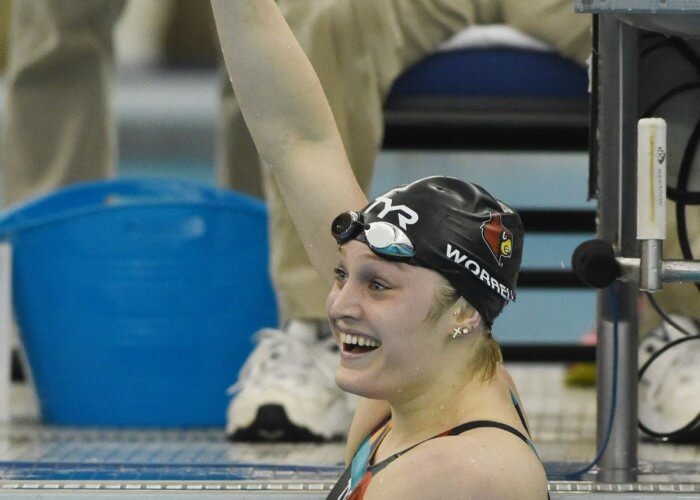Which Class Scored Big At Women’s D1 NCAAs?
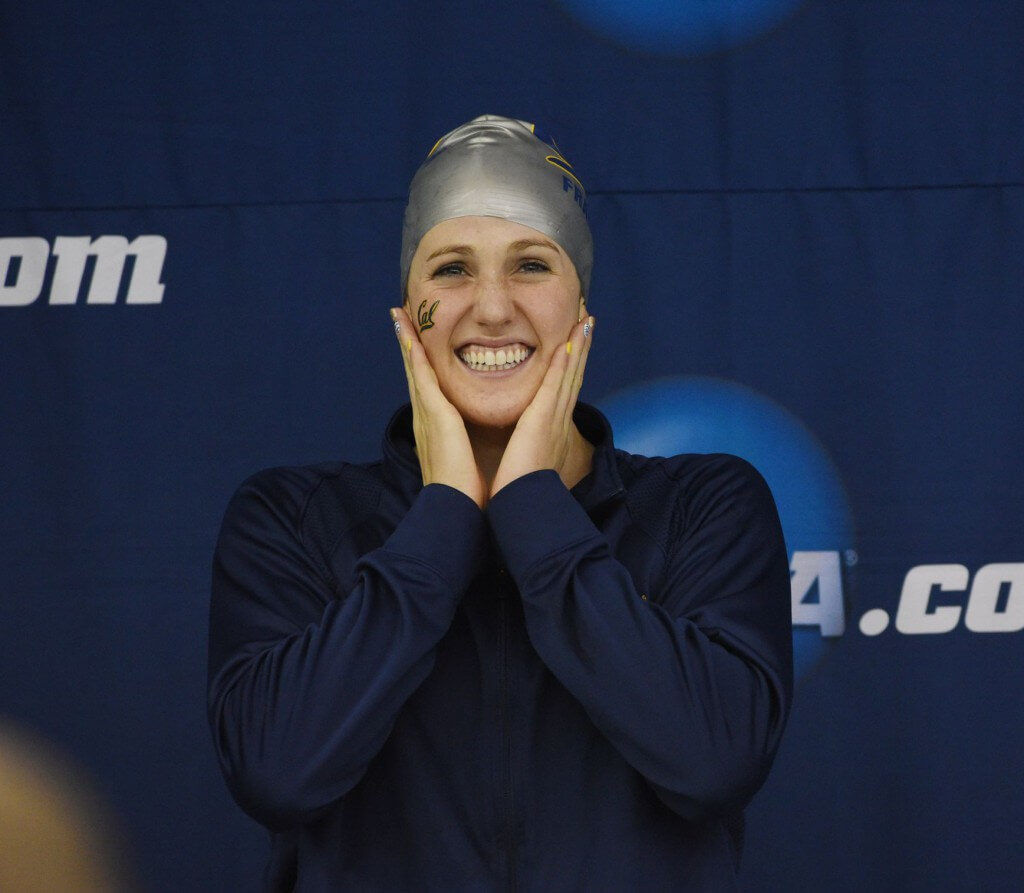
By Michael Grenon, Swimming World College Intern
A week before the NCAA Division I Men’s four-way class battle in Iowa City took place last March, the Division I Women fought their own battle in Greensboro. However, a different class emerged victorious. Sure, the California Golden Bears won the 63-team battle, but did the women’s classes differ drastically from the men’s?
Male and female NCAA swimmers tend to have different physiological responses to aging. Some would consider it extra experience, while others may consider it as a contributor to “burning out.”
A common assumption in this sport is that women generally “peak” before men do. If boys tend to gain traction throughout their collegiate careers to transition into men (re. heavy lifting, power-based training), can the same be said about girls transitioning into women? Although the physiology may generally be different between genders, what do the results suggest? You won’t have wait any longer to find out.
Note: Relays and diving are not included.
Figure 1 shows each individual event and how many points were scored by each class. The intensity of red represents the relative proportion of points earned for the event. In other words, darker red cells show that the respective class was very dominant in that event. If we assume all classes performed equally, they each should have scored around 39 (out of the total 155) points in each event.
The results look fairly similar to the men’s meet, but the women’s class of 2016 provided the twist. On the meet’s final day, the juniors stole the lead from the seniors and never looked back. They “out-touched” their older counterparts by a mere 17.5 points—less than 1% of all the individual points scored. For reference, that’s like being out-touched for the win by 0.17 seconds in the women’s 50 freestyle final.
Also, every class scored points in every individual event (as opposed to the senior men failing to score in the 1650 freestyle). In general, the distribution was more spread out among classes and among events. The freshmen women were again in the passenger seat as the more experienced classes raced to the top.
Figure 2 shows that juniors scored 30.4% of the 2015 total individual event points awarded at the meet, followed closely by the seniors (29.6%), sophomores (24.3%), and the freshmen (15.7%). Figure 3 below illustrates the points race in event order.
Although comparing genders is not a primary focus of this analysis, we can now look at the information provided by figure 4 below. It looks like these results are split; male freshmen and seniors outscored their female classmates whereas female “middleclassmen” outscored their male classmates. Class results are very comparable between both genders.
Fourth Place: Freshmen
The freshmen again were never in contention for the class team title at DI NCAAs. Some trends are definitely notable, though. Their strengths seemed to be the backstroke and sprint freestyle events, where Stanford’s Simone Manuel finished 1st-2nd-1st in an extremely impressive freshman sprint campaign.
The class of 2018 also had a very impactful backstroke crew, posting five finalists in the 100 and six in the 200. The only freshman to final in both distances was Hannah Weiss from USC.
Breaststroke was a definite weakness, where they only had one finals representative in each distance. Even with the rest of the NCAA event line-up points evenly distributed, the freshmen only managed to score better than par (38.75 points) in one of the thirteen individual events. They averaged 24.3 points per event.
Most valuable individual performers include Simone Manuel (57 points), California’s Sierra Runge (49 points), and Texas A&M’s Beryl Gastaldello (20 points).
Third Place: Sophomores
The sophomore women were competitive in the first day of events—a trend identical to their male classmates. However, they lacked overall depth to maintain that level against the upperclassmen.
Respectfully, they weren’t especially weak in any specific stroke or distance. If anything, mid-distance freestyle was a relative strength (think Missy Franklin and Leah Smith) and breaststrokes were relative point weaknesses, even with five and four finalists, respectively. They scored better than par in six of thirteen events.
MVPs include Cal’s Missy Franklin (60 points, the only triple event-winner of 2015 DI NCAAs), Virginia’s Leah Smith (52 points), and Cal’s Farida Osman (41 points). The class averaged 37.7 points per event.
Second Place: Seniors
The senior class of 2015 almost managed to have the “perfect” way to cap off their NCAA careers. Even while posting the meet’s most dominant single-class performance in an event, the 100 breaststroke (spookily similar to the senior men), the senior women couldn’t quite keep their lead on the juniors throughout the last day.
They even scored more than their fair share in as many as eight of thirteen individual events, but perhaps were too lopsided on the breastsroke/backstroke spectrum. That was the only noticable pattern in their event distribution, thanks to an at least 50% senior occupation of A-finalists in both breaststroke races.
Averaging a mighty 45.8 points per event, MVPs for the womens senior class include Texas A&M’s Sarah Henry (51 points), Notre Dame’s Emma Reaney (46 points), and Georgia’s Amber McDermott (45 points)
First Place: Juniors
Averaging 47.2 points per event, the class of 2016 are the 2015 Women’s NCAA DI class champions.
Showing true depth and versatility, they scored better than par on all but three events and had no signs of stroke/distance imbalances. Their one real weakness was the 200 freestyle amongst a very young field, even though having four representatives in the B-final.
On a better note, they managed to capture half of the A-final positions in both the 100 back and 200 breast. Their five most dominant races consisted of every stroke discipline and every distance (besides the 50).
Louisville’s American recordholder Kelsi Worrell (56 points), Virginia’s Courtney Bartholomew (48 points), and Georgia’s Hali Flickinger (46 points) are the champion class’s most valuable performers. Look for them to lead this class to a truly dominant 2016 NCAAs.
In Conclusion
Similar to the men, the DI women definitely showed that experience was one of the most valuable assets in the NCAA portfolio. While freshmen like Simone Manuel can definitely impact the meet, analysis suggests that experienced classes are the deepest and make the biggest points impact.
The similarities to the men’s meet were rather surprising. This may suggest, at least at the NCAA level, that the bulk of swimmers choosing this path tend to “peak” towards the end of or after their college careers, regardless of gender.
At next year’s women’s championships, will the class of 2016 run (or swim) away with the class race? The class of 2017 will not have their most valuable performer, Missy Franklin. Will they be able to step up without her? Will Simone Manuel lead the class of 2018 to title contention? Or will the class of 2019 bring something totally new to the table?
Only points will tell.




